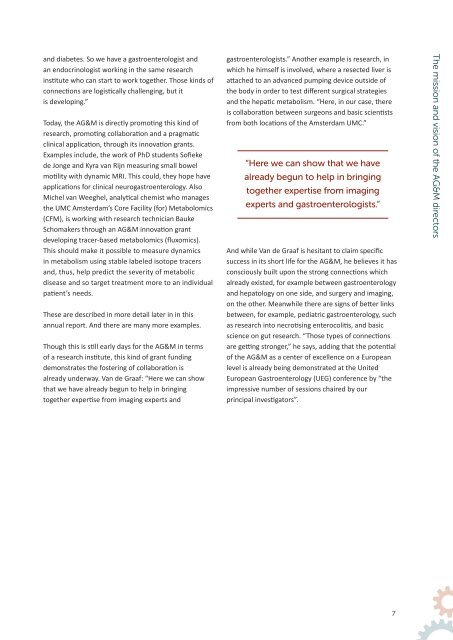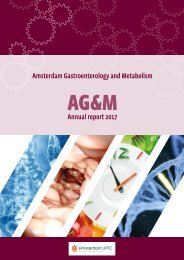AG&M annual report 2018
Create successful ePaper yourself
Turn your PDF publications into a flip-book with our unique Google optimized e-Paper software.
and diabetes. So we have a gastroenterologist and<br />
an endocrinologist working in the same research<br />
institute who can start to work together. Those kinds of<br />
connections are logistically challenging, but it<br />
is developing.”<br />
Today, the AG&M is directly promoting this kind of<br />
research, promoting collaboration and a pragmatic<br />
clinical application, through its innovation grants.<br />
Examples include, the work of PhD students Sofieke<br />
de Jonge and Kyra van Rijn measuring small bowel<br />
motility with dynamic MRI. This could, they hope have<br />
applications for clinical neurogastroenterology. Also<br />
Michel van Weeghel, analytical chemist who manages<br />
the UMC Amsterdam’s Core Facility (for) Metabolomics<br />
(CFM), is working with research technician Bauke<br />
Schomakers through an AG&M innovation grant<br />
developing tracer-based metabolomics (fluxomics).<br />
This should make it possible to measure dynamics<br />
in metabolism using stable labeled isotope tracers<br />
and, thus, help predict the severity of metabolic<br />
disease and so target treatment more to an individual<br />
patient’s needs.<br />
These are described in more detail later in in this<br />
<strong>annual</strong> <strong>report</strong>. And there are many more examples.<br />
Though this is still early days for the AG&M in terms<br />
of a research institute, this kind of grant funding<br />
demonstrates the fostering of collaboration is<br />
already underway. Van de Graaf: “Here we can show<br />
that we have already begun to help in bringing<br />
together expertise from imaging experts and<br />
gastroenterologists.” Another example is research, in<br />
which he himself is involved, where a resected liver is<br />
attached to an advanced pumping device outside of<br />
the body in order to test different surgical strategies<br />
and the hepatic metabolism. “Here, in our case, there<br />
is collaboration between surgeons and basic scientists<br />
from both locations of the Amsterdam UMC.”<br />
“Here we can show that we have<br />
already begun to help in bringing<br />
together expertise from imaging<br />
experts and gastroenterologists.”<br />
And while Van de Graaf is hesitant to claim specific<br />
success in its short life for the AG&M, he believes it has<br />
consciously built upon the strong connections which<br />
already existed, for example between gastroenterology<br />
and hepatology on one side, and surgery and imaging,<br />
on the other. Meanwhile there are signs of better links<br />
between, for example, pediatric gastroenterology, such<br />
as research into necrotising enterocolitis, and basic<br />
science on gut research. “Those types of connections<br />
are getting stronger,” he says, adding that the potential<br />
of the AG&M as a center of excellence on a European<br />
level is already being demonstrated at the United<br />
European Gastroenterology (UEG) conference by “the<br />
impressive number of sessions chaired by our<br />
principal investigators”.<br />
The mission and vision of the AG&M directors<br />
AG&M<br />
7



